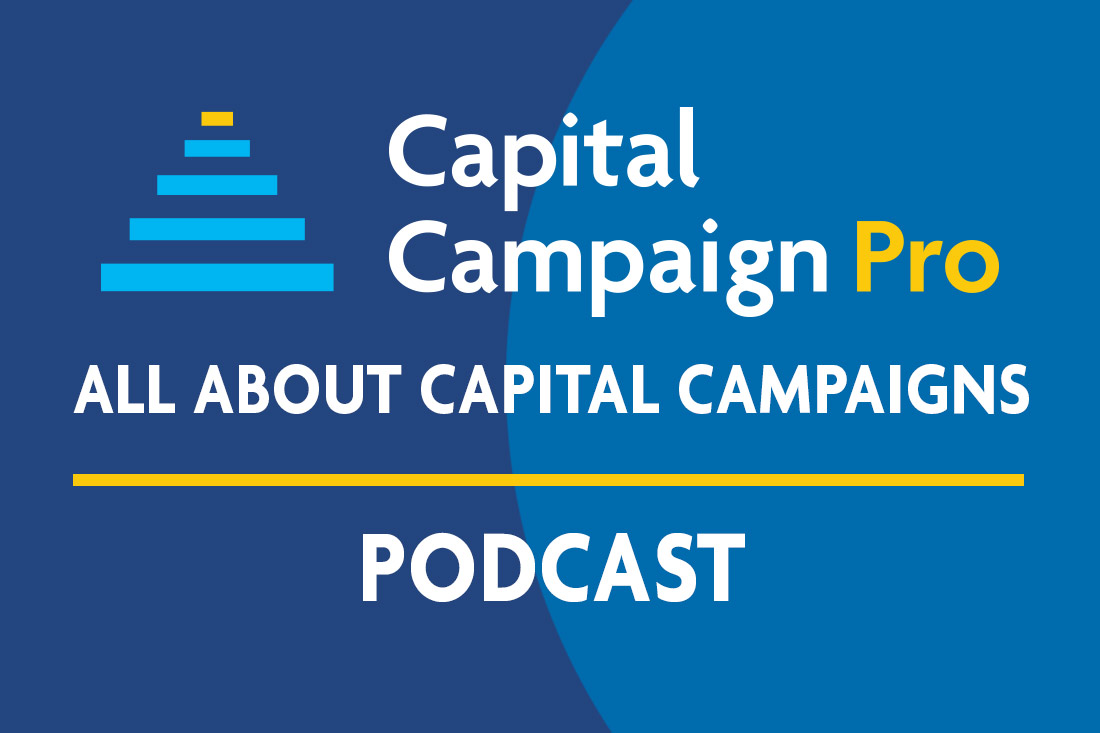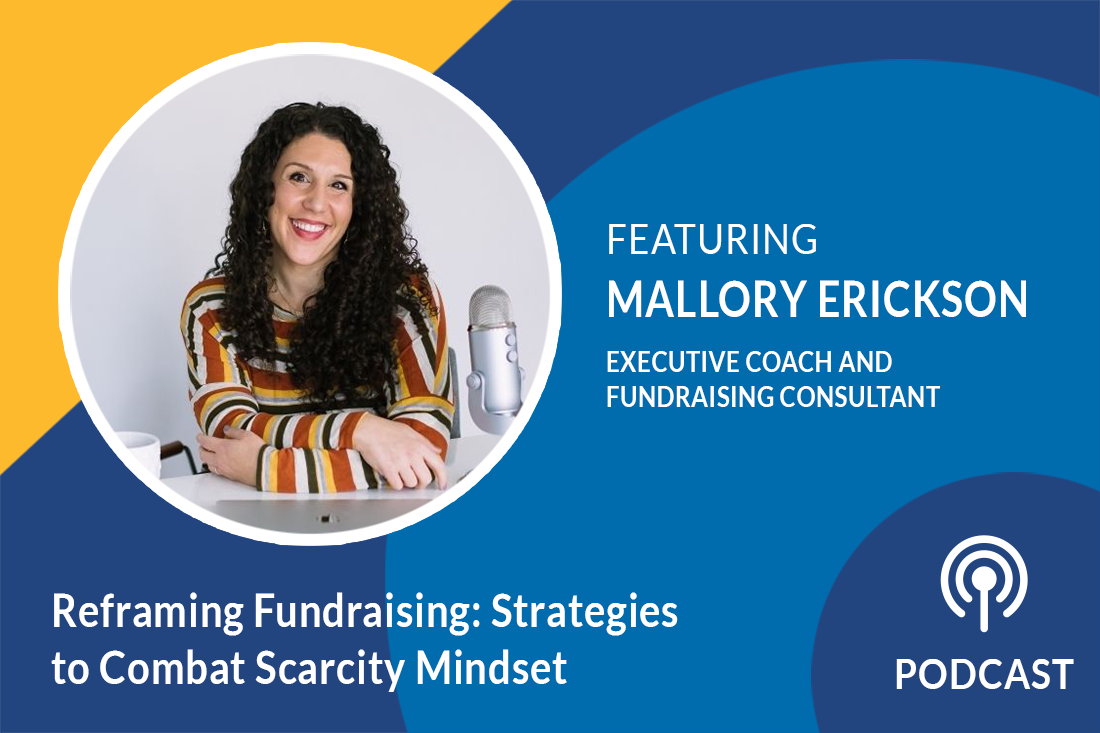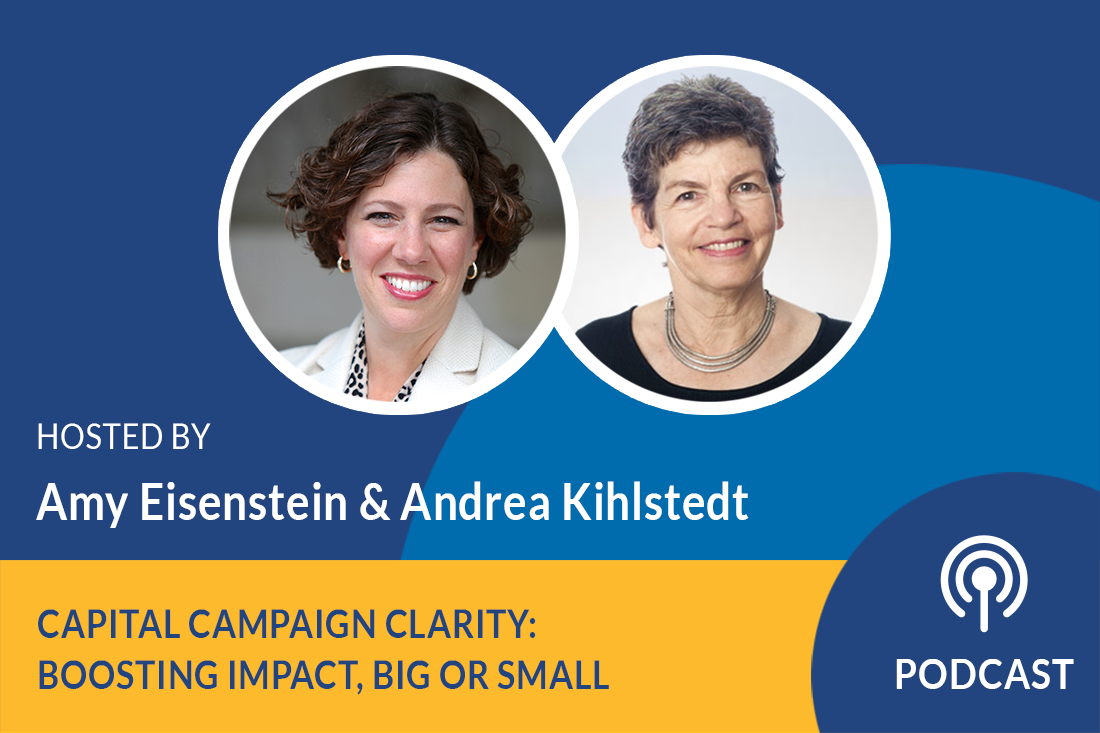Podcast: What is Endowment, and Does it Belong in your Capital Campaign?

Season 2, Episode 29
In this episode, capital campaign experts Amy Eisenstein and Andrea Kihlstedt discuss endowments. They’ll review what they are, why they matter, and why endowment should be included in your campaign fundraising objectives.
Listen Now:
This episode was recorded as part of a live webinar held Monday, March 7, 2022. To participate in future webinars, register at ToolkitTalks.com.
Amy Eisenstein:
We are excited to be talking about endowment, and how they relate to your campaign, if you should do an endowment campaign, if you should include a component of endowments in your campaign, and all of that exciting stuff.
So, Andrea, you are in the habit of kicking off the topic. So, why don’t you go ahead and do that for us today?
Andrea Kihlstedt:
Yes. So, I’m happy to do that. It turns out, and Amy and I spent a little while talking before we did this, and it turns out we have a lot to talk about with regard to endowment. But first, let me just start by, for those of you who don’t understand endowment, and we are certainly not experts in endowment, but we have some basic understanding. One of the things to understand is that, for many organizations, they have two kinds of endowment.
Two Kinds of Endowment
So, one kind of endowment is an endowment that is donor restricted. When a donor gives you a gift or leaves a gift to you in their wills, they do so with specific restrictions about how the money that spun off from that endowment can be spent. So, that’s a donor restricted endowment. In some sense, that’s what’s called true endowment. That you are not at liberty to change how that money gets spent, unless you do something extreme to actually go back and talk to the donor, or to talk to lawyers.
For the most part, many organizations have what is called quasi-endowment. And a quasi-endowment is money that behaves like endowment, but it is not donor risk restricted. It is board restricted. So, you have a pot of money that is invested. From that pot of money that is invested, your organization decides to take a certain percentage out every year to put into operating or whatever it is your organization decides it’s going to be spent on. The big difference is that, if your board should decide that they want to change how that money is used, they could do that. So, it pretends to be endowment. And the phrase often used is quasi-endowment. Most organizations love to have quasi-endowment, and we often speak about it as endowment, but you should know that there is a distinction between the two.
So, Amy, did I get that right? Does that sound clear to you?
Amy Eisenstein:
Yeah, I think that is right. So, the funds are invested by usually a committee of your board or somebody that you hire to help with those investments. And I think that you hit it right on the head, that quasi or quasi endowments are board designated directed endowments, and that it can be a rainy day fund if you need it for capital projects. The point is that when it’s board designated endowment, or quasi endowment, the principle can be invaded by your board with a vote. When it’s a donor directed, or true endowment, the principle cannot be invaded. And so, you can only use the interest from that pot of money.
Should You Do an Endowment Campaign?
So, I think the next real question for our topic today, for our purposes here today, is, A, should you do an endowment campaign? Should you consider an endowment campaign? And when and how should endowment be integrated into a bigger capital campaign? I think those are probably the two hot topics we’ve got for our conversation today. And I’ll start.
So, frequently, we get organizations coming to us and saying, “We want to do an endowment campaign.” And I’ll tell you why I think that’s not the best idea. The number one reason is that most donors, during their lifetime, are not supportive of endowments. I don’t mean that they are not supportive of them. They’re fine with the ideas of them, but they don’t want to give money to them. Because what happens is that, in order to have the same impact, you need to raise a multiplier. So, if somebody gives you $10,000 and you put it into an endowment or a restricted fund, and only use the interest, you only have access to a small, five percentage, of that every year, as opposed to being able to spend the whole $10,000 on whatever you’re doing.
So, most donors, during their lifetime, want to see their contributions be put to use for current or long-term programs and services, as opposed to in a planned gift or a bequest, which is when most people give to endowments. That’s how organizations traditionally grow their endowments, through planned gifts, through bequests. And so, when you’re thinking about doing a campaign, I want you to think about one, what are the real needs of your organization? And two, how do donors want to give and how do they give? And so do you want the vast majority of the gifts that are given to you tied up and not being able to be accessed? Or do you want to put them to good use right away? So, those are some of the things to start thinking about when thinking about endowment campaign. Andrea, why else do we not want to do endowment campaigns? Or when are they a good idea to include in campaigns?
All Campaigns Should Include Some Component of Endowment
Andrea Kihlstedt:
Well, I actually think that every campaign should include some component of endowment. So, let me just clarify this. I have several things to say. First of all, there are some donors — not a lot — but there are some donors who feel very strongly that organizations should have endowment, and they are willing to give their money to your endowment. There aren’t a lot of them, but there are some of them. And when that happens, you need to be ready to accept that, and to have the systems in place so you can make those people happy, and you can take their money and put it into your endowment.
Now, there are many people, particularly those who think of themselves as being fairly sophisticated investors who say to themselves, “I’m not at all confident that this organization makes investments as well as I do, could invest my money as well as I do. I’ve made money through investments. I’m pretty sophisticated at it. Why don’t I just keep making money through my investments, and then they should keep coming to me year after year? I don’t want to turn over my investments to them.”
So, that’s some of the thinking that you need to keep in mind. Now, let me, let me cover a couple of other things. The organizations that always make me laugh, not always in a kind way, I must confess, are the ones that say, “Why do you want to raise endowment?” They say, “Oh, we want to raise so much endowment, so we don’t have to raise money anymore.”
Amy Eisenstein:
That’s the answer, right?
Andrea Kihlstedt:
That’s what we hear. And what’s so interesting and funny about that, to me, is that I think that raising money is a very healthy and important part of the life of your organization. The process of raising money every year, of going back to donors every year, is a process of building those relationships. And the people who give you money are part of your tribe.
If you just take their money, put it into endowment and never speak with them again, because you don’t want to work on raising money, your organization won’t thrive. So, the principle of that, while I understand why people might think about it, it shows a profound lack of sophistication and understanding how important the fundraising process is to building relationships that will help your organization in multiple ways over time.
Amy Eisenstein:
I think, in addition to that, though, no matter how big an endowment is, it’s never enough. Let’s take Harvard, for example. Harvard probably, Stanford, they have some of the biggest endowments in the world, in the billions of dollars. And they still have teams, hundreds of fundraisers, who go out and are raising current and future gifts, and they are not apologetic about it.
And so, the idea that you’re going to get an endowment that’s big enough to run all your programs and services, so that you won’t have to fundraise anymore, is not realistic. And I just think, if you do an endowment campaign and you go to your donors and say, “We’re raising money for an endowment,” and they say, “You know what? That’s not something I’m going to invest in right now.” And you’re not doing a bigger campaign with other programs and services and offerings and opportunities, then you’ve gone out and talked to your donors, and nothing happened. You don’t have anything to raise money for.
So, to me, that’s the number one reason not to just do an endowment campaign, is that you’re taking the time and effort to go to donors, many of whom are going to say, “You know what? I might consider leaving something in my will for your endowment, but as for right now, and the next 10 or 20 years, that’s not the pot of money I want to give to. I want to give to something that’s current or big or exciting or now, and you need to have that opportunity to provide for them.
Andrea Kihlstedt:
Yes. There are two questions that I want to address. One is, why do I feel strongly that every campaign should have an endowment component? Now that we’ve just said you shouldn’t raise an endowment through your campaign. That’s question number one.
Amy Eisenstein:
Well, not exclusively. Not that you shouldn’t have a component. You should have a component, but it shouldn’t be the only component.
Andrea Kihlstedt:
The only component. So, why should you have a component? And that’s because when you are talking to your largest donors about their largest gift, which is what a campaign will enable you to do, you should be able to ask them, also, for a planned gift. You should have some component of your campaign that will benefit from a planned gift.
And if you’re raising, let’s say, $10 million for a new building, and someone says, “Well, I’d be happy to give you a planned gift. I’d be happy to include you in my estate for X number of dollars.” That’s not going to help with the building of your building. So, if the budget for the building is the only thing in your campaign, you can’t accept a planned gift into your campaign because it won’t help you achieve the objectives of your campaign.
So, you should have an endowment component, and because it doesn’t matter, really, if the money comes in for the endowment today or tomorrow, or in five years, or in 10 years, or longer, and if you have an endowment component, then you can accept planned gifts into your campaign. And if you don’t have an endowment component and your campaign is only for short term needs, you won’t be able to do that. So, that’s why, I think, it’s important in every campaign to have some aspect of an endowment.
Capital Campaigns and Endowment, Together
Amy Eisenstein:
Right. I think campaigns and endowment do go hand in hand, to some extent. For any long term project you’re doing, there are going to be long term needs. So, if you’re building a building, you’re going to need a maintenance fund. You’re going to need long term needs. And honestly, that’s the definition of a campaign, is getting to that longer term, boost your organization up in terms capacity to serve towards its mission, programs and services. So, an endowment can be a component of it, should be a piece of it, just not the whole thing.
And as Andrea said, when you’re talking to every major potential donor, you want to be talking about a gift to the campaign and a planned gift. You might as well talk to them about both while you’re sitting down in front of them, and people who make planned gifts today, those gifts are going to come to fruition 10 and 20, and maybe 30 years from now. So, you should be planting those seeds and having those conversations.
Andrea Kihlstedt:
You know, Amy, one topic that often comes up around the endowment component of a campaign, is how do you put a number on gifts that are given as estate gifts.
But one simple way to count planned gifts for your campaign is not to have a specific dollar goal for endowment, but to have what we call an activity goal. And instead of saying, “We want to raise $1 million towards our endowment,” you might say, “During the course of this campaign, we want to identify 40 people who will make estate commitments, who will document that they have included us in their wills, through this campaign process.”
Now, in fact, if you get 40 people to put your organization in their wills through the campaign, it is going to end up, over time, a significant amount of money. But it’s very easy to count when you have 40 new bequest intentions. That’s super easy to count. It’s far less easy to count how much those gifts are actually likely to amount to. That’s not a very good sentence.
Amy Eisenstein:
Yeah. To generate.
Andrea Kihlstedt:
To generate.
Amy Eisenstein:
To generate. Because people are going to include percentages in their will and not exact dollars. Of course, you don’t know when those dollars are coming in. And so, it makes much more sense to have, as part of your campaign goal, a planned gift goal of, as Andrea said, 40 new bequest intentions. And those will be recognized by the campaign in certain ways. And certainly, there’s lots of ways to think about recognizing planned gifts. Depending on the person’s age, you can recognize a percentage of it or a piece of it. I don’t think we’re going to go into that much detail today, but it’s certainly a topic of conversation that could take up another whole webinar.
Andrea Kihlstedt:
Yeah. We were working with someone who was a planned giving expert recently, and she said that she wouldn’t say you want 40 new people to put you in their will. She would say, “We want 40 new members of our planned giving society.” That’s a better way to calibrate it. I thought that was an interesting suggestion. But the idea is that you’re trying to get people to identify themselves as people who will, or have, made a planned gift to your organizations through the process of the campaign. And there’s nothing like being part of a group of people who are doing that, to motivate people to get more evolved.
Amy Eisenstein:
The reality is that your campaign donors are perfect planned giving prospects for the most part, because they are the ones who are interested in seeing the future of your organization succeed. And so, a planned gift and a big campaign gift often go hand in hand for those very reasons.



Leave a Comment